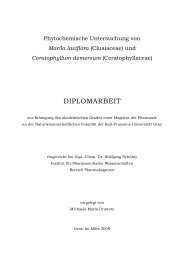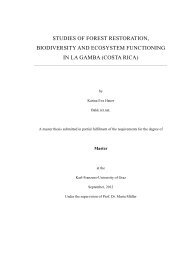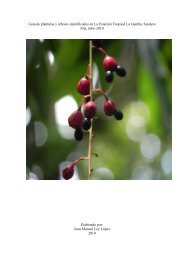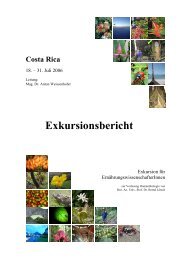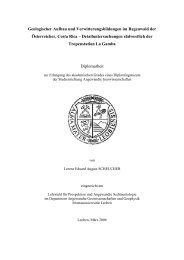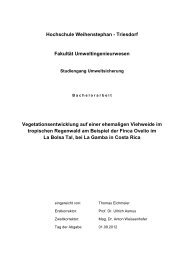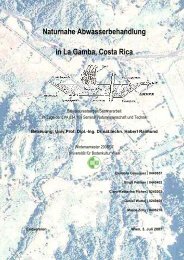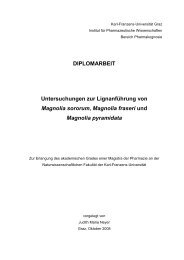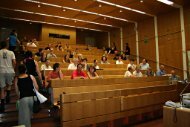Leaf colour patterns, vegetative and sexual reproduction of Episcia ...
Leaf colour patterns, vegetative and sexual reproduction of Episcia ...
Leaf colour patterns, vegetative and sexual reproduction of Episcia ...
Create successful ePaper yourself
Turn your PDF publications into a flip-book with our unique Google optimized e-Paper software.
Table 1: Measured floral characteristics <strong>of</strong> <strong>Episcia</strong> lilacina.<br />
n (number <strong>of</strong><br />
flowers measured)<br />
Average value <strong>and</strong> st<strong>and</strong>ard<br />
deviation (in mm)<br />
Minimum to<br />
Maximum (in mm)<br />
Length <strong>of</strong> corolla<br />
tube<br />
Width <strong>of</strong> the<br />
flower entrance<br />
Height <strong>of</strong> the<br />
flower entrance<br />
Width <strong>of</strong> the<br />
widest part <strong>of</strong> tube<br />
Height <strong>of</strong> the<br />
widest part <strong>of</strong> tube<br />
Width <strong>of</strong> the<br />
narrowest part <strong>of</strong><br />
tube<br />
Height <strong>of</strong> the<br />
narrowest part <strong>of</strong><br />
tube<br />
25 38 ± 2,62 29 – 41<br />
25 3 ± 0,5 2 – 4<br />
25 5,8 ± 0,64 5 – 7<br />
25 4,5 ± 0,91 3 – 6<br />
25 7,4 ± 0,65 6 – 8<br />
25 3,5 ± 0,77 1 – 5<br />
25 4,8 ± 0,62 4 – 6<br />
Limb diameter 25 42 ± 3,46 35 – 49<br />
Length <strong>of</strong> stamina 21 17 ± 1,49 13 – 20<br />
Length <strong>of</strong> style 21 15 ± 1,10 12 – 17<br />
Height <strong>of</strong> ovary 21 2,9 ± 0,38 2 – 4<br />
Diameter <strong>of</strong> ovary 21 2,1 ± 0,30 2 – 3<br />
Discussion: The limiting factor considering the legitimate pollinator is the tube <strong>of</strong> <strong>Episcia</strong><br />
lilacina. The average length <strong>of</strong> tube <strong>of</strong> 38 mm implies that the proboscis <strong>of</strong> the pollinator has to<br />
be <strong>of</strong> about equal length, because there exists an evolutionary correlation between tube length<br />
<strong>and</strong> proboscis length (Nilsson 1988). Bumblebees, for instance, belong to the largest insects<br />
acting as legitimate pollinators, but possess proboscises approaching only 10 mm in length (Barth<br />
1991). Insects that are to be considered effective pollinators thus only include butterflies<br />
(Lepidoptera) <strong>and</strong> large neotropical bees e.g. Euglossini.<br />
55



